Many Singaporeans are familiar with the tradition of using mistletoes as Christmas decorations in temperate countries, and that a man and a woman who meet under the mistletoe decoration are obliged to kiss. Most of these people, however, do not know that mistletoes can also be found in tropical countries, and they are actually very common in Singapore.
Mistletoes are obligate hemiparasitic shrubs from the order Santalales that grow attached to the stems and branches of trees or shrubs.
A) What are Parasitic Plants?
Parasitic plants are plants which get some or all their required sustenance from other plants. They have specialised roots called haustoria which penetrate into the host plants' tissues, connecting to the xylem, phloem, or both. Those which get all their sustenance from other plants are known as "holoparasites", while those which are parasitic under natural conditions and are also photosynthetic to some extend are known as "hemiparasites" or "semiparasites".
Parasitic plants can also be "obligate parasites" which cannot complete their life cycles without a host, or "facultative parasites" which can complete their life cycles with or without a host. So obviously, all holoparasites are obligate parasites.

As mistletoes are attached to the stems and branches of trees or shrubs, they are hence also often called "stem parasites". The above photo features several species of mistletoes (can be differentiated by the different types of leaves) infesting a tree.

Their haustoria penetrate into the host plants' tissues to draw water and non-organic nutrients, but they possess chlorophyll, and hence are able to photosynthesize to produce their own sugar. The above features the haustoria of the Common Malayan Mistletoe (Dendrophthoe pentandra).

A healthy tree can usually support a good number of mistletoes, but if a tree growing on poor soil is infested by too many mistletoes, its health can be further worsened since the mistletoes will be competing with it for water, mineral nutrients and sunlight. For example, the tree above was so badly infested with Mulberry Mistletoes (Taxillus chinensis) that its leaves were mostly in the shade of the latter, and only a few were exposed to the sun. At the same time, the many mistletoes drained the water and nutrients from the tree. Half the tree eventually dried up, and when the host died, the mistletoes died too.

As such, the authorities sometimes have to manage the number of mistletoes growing on our trees. The Penaga Laut (Calophyllum inophyllum) above is a Heritage Tree supporting lots of mistletoes of several species. It is important to note that management of mistletoes does not necessarily mean removing all the mistletoes, but rather, a combination of removing some of the mistletoes and improving the soil quality in the surrounding. Despite the traditional gardeners' belief that mistletoes are harmful to plants, they actually play very important roles in the ecosystems.
B) Importance of Mistletoes
Recent studies have shown that mistletoes are keystone species in forests and woodlands. A keystone is the most important stone in an arch, and if removed will cause the arch to collapse. A keystone species is therefore one which has a very significant influence in an ecosystem, and if removed will cause drastic changes. Many birds, insects and aboreal mammals build their nests among mistletoes. Also, a very wide variety of animals feed on the leaves, shoots, fruits (called pseudo berries as they lack true ovules), flowers and nectar of mistletoes.

The above photo features a female Olive-backed Sunbird (Cinnyris jugularis), feeding on the nectar produced by the flowers of the mistletoe Macrosolen retusus.

Mistletoes also serve as host plants for many species of butterflies. The above photo features the caterpillars of the Painted Jezebel (Delias hyparete metarete) feeding on the leaves of a Common Malayan Mistletoe (Dendrophthoe pentandra).

The mistletoes in Singapore are largely dispersed by birds, such as flowerpeckers and bulbuls. The above features a Juvenile Scarlet-backed Flowerpecker (Dicaeum cruentatum) with an unripe pseudo berry of the Common Chinese Mistletoe (Macrosolen cochincinensis). In some cases, the single seed is squeezed out of the fruit as the bird grips on the fruit with its beak. The seed, which has a sticky seed coat, often sticks to the beak of the birds (or drops onto a branch with luck), which the bird will wipe it off on a branch. In other cases, the bird will swallow the whole fruit with the seed. The seed will go through the bird's gut system, and get excreted on the branch the bird is perching on. As the seed is quite sticky, it may get stuck to the bottom of the bird when it is excreted. The bird hence have to wipe its bottom on the branch it is perching on to get rid of the sticky seeds. When the seeds are stuck on the branch of a suitable tree/shrub, it will germinate and send out a small shoot to attach itself to the branch, and eventually enters the tissues to extract water and non-organic nutrients.
In fact, mistletoes are called "mistiltan" in old English, and "mistel" means "dung" while "tan" means twig. Putting the two together it means "dung on a twig", refering to how the seeds are dispersed.
Traditionally, several species of mistletoes were used to treat cough, diabetes, hypertension, and skin infection etc. Recent studies on mistletoes have also shown some species to possess antidiabetes, anticancer, antinociceptive and antioxidant compounds.
C) Mistletoes of Singapore
In Singapore, 16 species of mistletoes were recorded as of the year 2011, but 8 were already extinct. The extant species comprise six species from the family Loranthaceae, and two species from the family Santalaceae. Recently, two more new records were discovered, and I will put up details about when the status is confirmed. Here are the extant species that I have personally seen.

The Common Malayan Mistletoe (Dendrophthoe pentandra) from the family Loranthaceae is one of the commonest and most widespread mistletoes in Singapore - I have seen it in almost every park and residential areas. This shrub can grow to about 2m tall. Studies have shown that this species contains natural antioxidant and antidiabetes compounds.

It has thick and leathery leaves, usually with a glossy surface. The leaf shape, however, is very variable, and can be elliptic as seen above, ovate or even lanceolate.

Here's another leaf on the same plant with which has a very different shape from the leaves in the previous photo. It has a wavy margin, and is more ovate in shape. A few pairs of obvious lateral veins can usually be seen.

The young leaves, especially those in more open areas, are often reddish in colour.
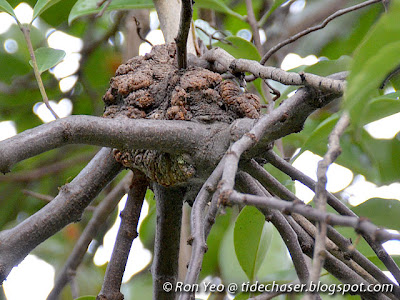
The Common Malayan Mistletoe tends to "hijack" the branch's xylem, and as the mistletoe matures, the part of the branch beyond the mistletoe often dries up and breaks off. The haustoria often appear very much enlarged, with a ball-like shape.
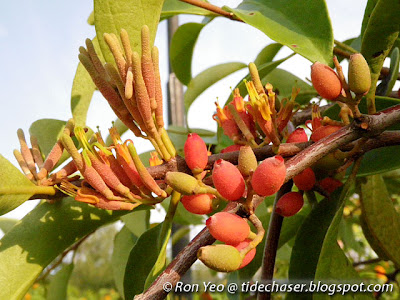
As the leaves are so variable, it is usually easier to identify it by the flowers and fruits. The flowers occur in small bunches. They are pinkish-orange in colour and tubular in shape. All flowers of the mistletoes from the family Loranthaceae are bisexual with both male and female reproductive parts. The pseudo berry is about 1cm long, oval-shaped, and turns reddish or orange as it matures. The skin is often covered with tiny bumps.

Here's the seedling of the Common Malayan Mistletoe.

The Common Chinese Mistletoe (Macrosolen cochincinensis), also from the family Loranthaceae, is another very common and widespread mistletoe, infesting a wide variety of trees and shrubs in most parks and residential areas all over Singapore.

The leaves are usually thick and leathery, but the surface is not glossy, unlike the previous species. The leaves of mature plants are often more consistently ovate in shape with a pointed tip.

The leaves of young plants may appear more elongated though.

The Common Chinese Mistletoe often has many side roots running along the branch of the host. In the above photo, you can see the haustoria growing into the host branch.

The flowers, occuring in small bunches, are green with numerous white stamens, and the petals are yellow-tipped.
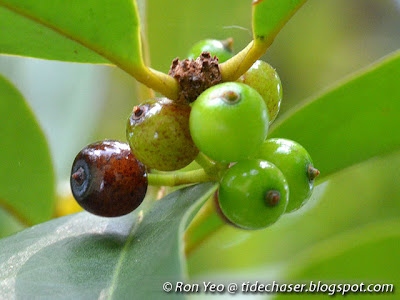
The pseudo berries are round, about 5mm in size, turning from green to dark reddish brown as they mature.
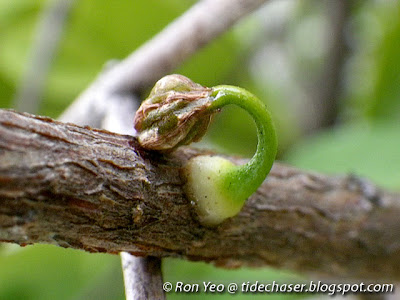
Here's a seedling of the Common Chinese Mistletoe.

Closely related to the previous species, the Pink-flowered Mistletoe (Macrosolen retusus) is quite rare in Singapore. I have only seen small populations on St John's Island, Kusu Island, Mount Vernon, Simei and Cantebury Road. They appear to be more selective on their hosts as well, as so far I have only seen them infesting the Penaga Laut (Calophyllum inophyllum), Podocarpus (Podocarpus spp.) and Salam (Syzygium polyanthum).

The leaves are thick, leathery and firm. They are usually obovate or inversely heart-shaped due to a notch at the end.

The leaves of seedlings are more elongated. The seedlings can grow on leaves too, with the haustoria growing into the leaf veins.

As the plant matures, the side roots extend around the host branch, sticking the many haustoria into the latter along the way.

However, I have also seen instances whereby a single stem attaching itself to the host branch without the many side roots.

The flowers are spectacular - being pink in colour.

The fruits started off green in colour, before turning yellow, then red, and eventually, black as they mature. Mature fruits are about 1cm long.

Here's a germinating Pink-flowered Mistletoe.

The Mulberry Mistletoe (Taxillus chinensis), again from the family Loranthaceae, is rather abundant in the vicinity of East Coast Park, Marine Parade Road and East Coast Road, but rarely seen elsewhere in Singapore.

The ones seen in Singapore generally have leathery and glossy ovate leaves with wavy edges.

Young plants tend to have more elongated leaves. Like the previous species, they have side roots running along the length of the host branch, sticking their haustoria into the latter at various intervals.

Mature Mulberry Mistletoes cling to the host so tightly, that they often "eat" into the stem of the latter. The stem of this mistletoe is usually covered with numerous tiny wart-like markings.

The flowers open on one side, appearing like a little paw.

The fruits, which some imagination, resemble mulberry (hence the common name), but are yellow in colour when mature. They are about 1cm long.

The Rusty-leaf Mistletoe (Scurrula ferruginea) from the same family is quite widespread but generally not common in Singapore. Good populations can be found in the vicinities of Buona Vista, Dover, East Coast, Mount Vernon, Fort Canning Hill, Serangoon Gardens, Central Nature Reserves, Western Catchment and our Northern Islands.

The leaves are usually ovate with obvious veins. They are green on top, but covered with a layer of fine brown hair below, giving it a "rusty" appearance.

Some specimens may have more elliptic leaves with less obvious veins though.

The main stem of this mistletoe attaches to the host rather seamlessly, with a few side roots extending along the sides of the branch, growing the many little haustoria into the latter.

The flower has the appearance of a little hairy paw, opening on one side.

The fruit is a small hairy pseudo berry, about 1cm long.
Singapore has another Scurrula species, Scurrula parasitica, which I am still hoping to see and photograph one day!

The Oval-leaved Mistletoe (Viscum ovalifolium) is one of the two native mistletoes from the family Santalaceae (previously under Viscaceae). It is rather widespread but not very common in Singapore. I have seen good populations in Kent Ridge, Buona Vista, Bidadari, Fort Canning Hill, Central Nature Reserves, Western Catchment and both our southern and northern islands. The colour of the mistletoe varies from dark green to yellow. The above photo features one that is dark green in colour.

This one is yellowish brown in colour.

The species name "ovalifolium" means "oval leaves". The leaves of the Oval-leaved Mistletoe are usually somewhat oval-shaped or elliptic, with 3-5 veins.

Viscum mistletoes generally lack the creeping side roots and are connected to the host at only one point.

The tiny flowers are yellow in colour. Mistletoes from the family Santalaceae have unisexual flowers arranged in groups of three - the one in the middle is a female flower, which develops earlier than the 2 lateral male flowers.
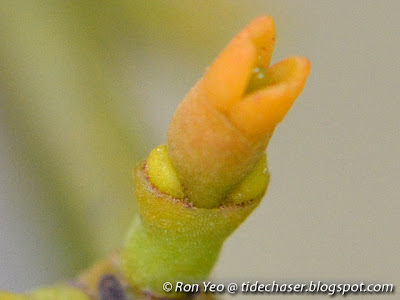
In the photo above, you can see the budding male flowers (the two yellow structures) on both sides of the female flower.

The fruit is about 5mm across, and turns orange or yellowish brown as it matures.
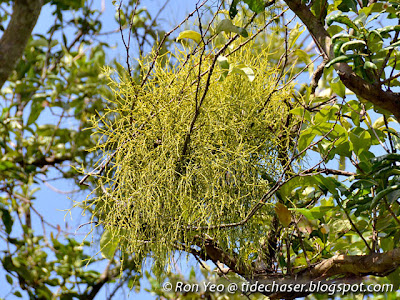
Also from the family Santalaceae, the Leafless Mistletoe (Viscum articulatum) is very rare in Singapore, as it is a hyperparasite (a mistletoe that parasitise another mistletoe). I have only seen it around Cantebury Road, Sembawang and St John's Island, though I have heard from friends that it can be found at Dunearn Road and Lazarus Island as well. The above photo features one infesting a Common Malayan Mistletoe.

This one above was parasitising a Pink-flowered Mistletoe.

As its common name implies, it has no leaves, and in fact, unlike the previous species, does not even have phyllodes. The green stems perform the required photosynthesis instead.

Like the previous species, the Leafless Mistletoe is attached to the host at one point.

The flowers are unisexual, and occur in groups of three, with the female flower in the middle, and the two male flowers by the sides which develop much later than the female flower. The above photo features a male flower.

The mature fruits are round and white in colour, about 3-4mm in size.

The above photo features the germinating seeds of the Leafless Mistletoe.
Special thanks to my mistletoe kakis, John and Francis, for keeping me updated of the latest news on our local mistletoes!
References
Mistletoes are obligate hemiparasitic shrubs from the order Santalales that grow attached to the stems and branches of trees or shrubs.
A) What are Parasitic Plants?
Parasitic plants are plants which get some or all their required sustenance from other plants. They have specialised roots called haustoria which penetrate into the host plants' tissues, connecting to the xylem, phloem, or both. Those which get all their sustenance from other plants are known as "holoparasites", while those which are parasitic under natural conditions and are also photosynthetic to some extend are known as "hemiparasites" or "semiparasites".
Parasitic plants can also be "obligate parasites" which cannot complete their life cycles without a host, or "facultative parasites" which can complete their life cycles with or without a host. So obviously, all holoparasites are obligate parasites.

As mistletoes are attached to the stems and branches of trees or shrubs, they are hence also often called "stem parasites". The above photo features several species of mistletoes (can be differentiated by the different types of leaves) infesting a tree.

Their haustoria penetrate into the host plants' tissues to draw water and non-organic nutrients, but they possess chlorophyll, and hence are able to photosynthesize to produce their own sugar. The above features the haustoria of the Common Malayan Mistletoe (Dendrophthoe pentandra).

A healthy tree can usually support a good number of mistletoes, but if a tree growing on poor soil is infested by too many mistletoes, its health can be further worsened since the mistletoes will be competing with it for water, mineral nutrients and sunlight. For example, the tree above was so badly infested with Mulberry Mistletoes (Taxillus chinensis) that its leaves were mostly in the shade of the latter, and only a few were exposed to the sun. At the same time, the many mistletoes drained the water and nutrients from the tree. Half the tree eventually dried up, and when the host died, the mistletoes died too.

As such, the authorities sometimes have to manage the number of mistletoes growing on our trees. The Penaga Laut (Calophyllum inophyllum) above is a Heritage Tree supporting lots of mistletoes of several species. It is important to note that management of mistletoes does not necessarily mean removing all the mistletoes, but rather, a combination of removing some of the mistletoes and improving the soil quality in the surrounding. Despite the traditional gardeners' belief that mistletoes are harmful to plants, they actually play very important roles in the ecosystems.
B) Importance of Mistletoes
Recent studies have shown that mistletoes are keystone species in forests and woodlands. A keystone is the most important stone in an arch, and if removed will cause the arch to collapse. A keystone species is therefore one which has a very significant influence in an ecosystem, and if removed will cause drastic changes. Many birds, insects and aboreal mammals build their nests among mistletoes. Also, a very wide variety of animals feed on the leaves, shoots, fruits (called pseudo berries as they lack true ovules), flowers and nectar of mistletoes.

The above photo features a female Olive-backed Sunbird (Cinnyris jugularis), feeding on the nectar produced by the flowers of the mistletoe Macrosolen retusus.

Mistletoes also serve as host plants for many species of butterflies. The above photo features the caterpillars of the Painted Jezebel (Delias hyparete metarete) feeding on the leaves of a Common Malayan Mistletoe (Dendrophthoe pentandra).

The mistletoes in Singapore are largely dispersed by birds, such as flowerpeckers and bulbuls. The above features a Juvenile Scarlet-backed Flowerpecker (Dicaeum cruentatum) with an unripe pseudo berry of the Common Chinese Mistletoe (Macrosolen cochincinensis). In some cases, the single seed is squeezed out of the fruit as the bird grips on the fruit with its beak. The seed, which has a sticky seed coat, often sticks to the beak of the birds (or drops onto a branch with luck), which the bird will wipe it off on a branch. In other cases, the bird will swallow the whole fruit with the seed. The seed will go through the bird's gut system, and get excreted on the branch the bird is perching on. As the seed is quite sticky, it may get stuck to the bottom of the bird when it is excreted. The bird hence have to wipe its bottom on the branch it is perching on to get rid of the sticky seeds. When the seeds are stuck on the branch of a suitable tree/shrub, it will germinate and send out a small shoot to attach itself to the branch, and eventually enters the tissues to extract water and non-organic nutrients.
In fact, mistletoes are called "mistiltan" in old English, and "mistel" means "dung" while "tan" means twig. Putting the two together it means "dung on a twig", refering to how the seeds are dispersed.
Traditionally, several species of mistletoes were used to treat cough, diabetes, hypertension, and skin infection etc. Recent studies on mistletoes have also shown some species to possess antidiabetes, anticancer, antinociceptive and antioxidant compounds.
C) Mistletoes of Singapore
In Singapore, 16 species of mistletoes were recorded as of the year 2011, but 8 were already extinct. The extant species comprise six species from the family Loranthaceae, and two species from the family Santalaceae. Recently, two more new records were discovered, and I will put up details about when the status is confirmed. Here are the extant species that I have personally seen.

The Common Malayan Mistletoe (Dendrophthoe pentandra) from the family Loranthaceae is one of the commonest and most widespread mistletoes in Singapore - I have seen it in almost every park and residential areas. This shrub can grow to about 2m tall. Studies have shown that this species contains natural antioxidant and antidiabetes compounds.

It has thick and leathery leaves, usually with a glossy surface. The leaf shape, however, is very variable, and can be elliptic as seen above, ovate or even lanceolate.

Here's another leaf on the same plant with which has a very different shape from the leaves in the previous photo. It has a wavy margin, and is more ovate in shape. A few pairs of obvious lateral veins can usually be seen.

The young leaves, especially those in more open areas, are often reddish in colour.

The Common Malayan Mistletoe tends to "hijack" the branch's xylem, and as the mistletoe matures, the part of the branch beyond the mistletoe often dries up and breaks off. The haustoria often appear very much enlarged, with a ball-like shape.

As the leaves are so variable, it is usually easier to identify it by the flowers and fruits. The flowers occur in small bunches. They are pinkish-orange in colour and tubular in shape. All flowers of the mistletoes from the family Loranthaceae are bisexual with both male and female reproductive parts. The pseudo berry is about 1cm long, oval-shaped, and turns reddish or orange as it matures. The skin is often covered with tiny bumps.

Here's the seedling of the Common Malayan Mistletoe.

The Common Chinese Mistletoe (Macrosolen cochincinensis), also from the family Loranthaceae, is another very common and widespread mistletoe, infesting a wide variety of trees and shrubs in most parks and residential areas all over Singapore.

The leaves are usually thick and leathery, but the surface is not glossy, unlike the previous species. The leaves of mature plants are often more consistently ovate in shape with a pointed tip.

The leaves of young plants may appear more elongated though.

The Common Chinese Mistletoe often has many side roots running along the branch of the host. In the above photo, you can see the haustoria growing into the host branch.

The flowers, occuring in small bunches, are green with numerous white stamens, and the petals are yellow-tipped.

The pseudo berries are round, about 5mm in size, turning from green to dark reddish brown as they mature.

Here's a seedling of the Common Chinese Mistletoe.

Closely related to the previous species, the Pink-flowered Mistletoe (Macrosolen retusus) is quite rare in Singapore. I have only seen small populations on St John's Island, Kusu Island, Mount Vernon, Simei and Cantebury Road. They appear to be more selective on their hosts as well, as so far I have only seen them infesting the Penaga Laut (Calophyllum inophyllum), Podocarpus (Podocarpus spp.) and Salam (Syzygium polyanthum).

The leaves are thick, leathery and firm. They are usually obovate or inversely heart-shaped due to a notch at the end.

The leaves of seedlings are more elongated. The seedlings can grow on leaves too, with the haustoria growing into the leaf veins.

As the plant matures, the side roots extend around the host branch, sticking the many haustoria into the latter along the way.

However, I have also seen instances whereby a single stem attaching itself to the host branch without the many side roots.

The flowers are spectacular - being pink in colour.

The fruits started off green in colour, before turning yellow, then red, and eventually, black as they mature. Mature fruits are about 1cm long.

Here's a germinating Pink-flowered Mistletoe.

The Mulberry Mistletoe (Taxillus chinensis), again from the family Loranthaceae, is rather abundant in the vicinity of East Coast Park, Marine Parade Road and East Coast Road, but rarely seen elsewhere in Singapore.

The ones seen in Singapore generally have leathery and glossy ovate leaves with wavy edges.

Young plants tend to have more elongated leaves. Like the previous species, they have side roots running along the length of the host branch, sticking their haustoria into the latter at various intervals.

Mature Mulberry Mistletoes cling to the host so tightly, that they often "eat" into the stem of the latter. The stem of this mistletoe is usually covered with numerous tiny wart-like markings.

The flowers open on one side, appearing like a little paw.

The fruits, which some imagination, resemble mulberry (hence the common name), but are yellow in colour when mature. They are about 1cm long.

The Rusty-leaf Mistletoe (Scurrula ferruginea) from the same family is quite widespread but generally not common in Singapore. Good populations can be found in the vicinities of Buona Vista, Dover, East Coast, Mount Vernon, Fort Canning Hill, Serangoon Gardens, Central Nature Reserves, Western Catchment and our Northern Islands.

The leaves are usually ovate with obvious veins. They are green on top, but covered with a layer of fine brown hair below, giving it a "rusty" appearance.

Some specimens may have more elliptic leaves with less obvious veins though.

The main stem of this mistletoe attaches to the host rather seamlessly, with a few side roots extending along the sides of the branch, growing the many little haustoria into the latter.

The flower has the appearance of a little hairy paw, opening on one side.

The fruit is a small hairy pseudo berry, about 1cm long.
Singapore has another Scurrula species, Scurrula parasitica, which I am still hoping to see and photograph one day!

The Oval-leaved Mistletoe (Viscum ovalifolium) is one of the two native mistletoes from the family Santalaceae (previously under Viscaceae). It is rather widespread but not very common in Singapore. I have seen good populations in Kent Ridge, Buona Vista, Bidadari, Fort Canning Hill, Central Nature Reserves, Western Catchment and both our southern and northern islands. The colour of the mistletoe varies from dark green to yellow. The above photo features one that is dark green in colour.

This one is yellowish brown in colour.

The species name "ovalifolium" means "oval leaves". The leaves of the Oval-leaved Mistletoe are usually somewhat oval-shaped or elliptic, with 3-5 veins.

Viscum mistletoes generally lack the creeping side roots and are connected to the host at only one point.

The tiny flowers are yellow in colour. Mistletoes from the family Santalaceae have unisexual flowers arranged in groups of three - the one in the middle is a female flower, which develops earlier than the 2 lateral male flowers.

In the photo above, you can see the budding male flowers (the two yellow structures) on both sides of the female flower.

The fruit is about 5mm across, and turns orange or yellowish brown as it matures.

Also from the family Santalaceae, the Leafless Mistletoe (Viscum articulatum) is very rare in Singapore, as it is a hyperparasite (a mistletoe that parasitise another mistletoe). I have only seen it around Cantebury Road, Sembawang and St John's Island, though I have heard from friends that it can be found at Dunearn Road and Lazarus Island as well. The above photo features one infesting a Common Malayan Mistletoe.

This one above was parasitising a Pink-flowered Mistletoe.

As its common name implies, it has no leaves, and in fact, unlike the previous species, does not even have phyllodes. The green stems perform the required photosynthesis instead.

Like the previous species, the Leafless Mistletoe is attached to the host at one point.

The flowers are unisexual, and occur in groups of three, with the female flower in the middle, and the two male flowers by the sides which develop much later than the female flower. The above photo features a male flower.

The mature fruits are round and white in colour, about 3-4mm in size.

The above photo features the germinating seeds of the Leafless Mistletoe.
Special thanks to my mistletoe kakis, John and Francis, for keeping me updated of the latest news on our local mistletoes!
References
- Artanti, N, T. Firmansyah and A. Darmawan, 2012. Bioactivities evaluation of Indonesian mistletoes (Dendrophthoe pentandra (L.) Miq.) leaves extracts. Journal of Applied Pharmaceutical Science 02 (01); 2012: 24-27
- Chong, K. Y., H. T. W. Tan and R. T. Corlett, 2009. A Checklist of the Total Vascular Plant Flora of Singapore: Native, Naturalised and Cultivated Species. Raffles Museum of Biodiversity Research, National University of Singapore. Singapore. 273 pp.
- Der, J. P. and D. L. Nickrent, 2008. A molecular phylogeny of Santalaceae (Santalales). Systematic Botany 33: 107-116.
- Flora of China. Retrieved Nov 3, 2012, from http://www.efloras.org.
- Lim, F. 2011. Singapore Mistletoe Story: An Expose of a Botanical Marvel. Carnegale Press. Singapore. 116pp.
- Mistletoes 2: seeds and germination. Bird Ecology Study Group. Retrieved Nov 3, 2012, from http://www.besgroup.org/2006/01/27/mistletoes-2-seeds-and-germination/.
- Nickrent, D. L. 2001. Santalales (Mistletoe). Treatment A3714 in Encyclopedia of Life Sciences, Macmillan Publishers Ltd.
- Rahman M. M., M. A. U. Chowdhury, M. E. Uddin, A. M. T. Islam and M. A. Hossain. 2012. Macrosolen cochinchinensis (Lour.): anti-nociceptive and antioxidant activity. Asian Pacific Journal of Tropical Biomedicine (2012): S203-S207.
- Vidal-Russell, R. and D. L. Nickrent, 2008. Evolutionary relationships in the showy mistletoe family (Loranthaceae). American Journal of Botany 95: 1015-1029.
